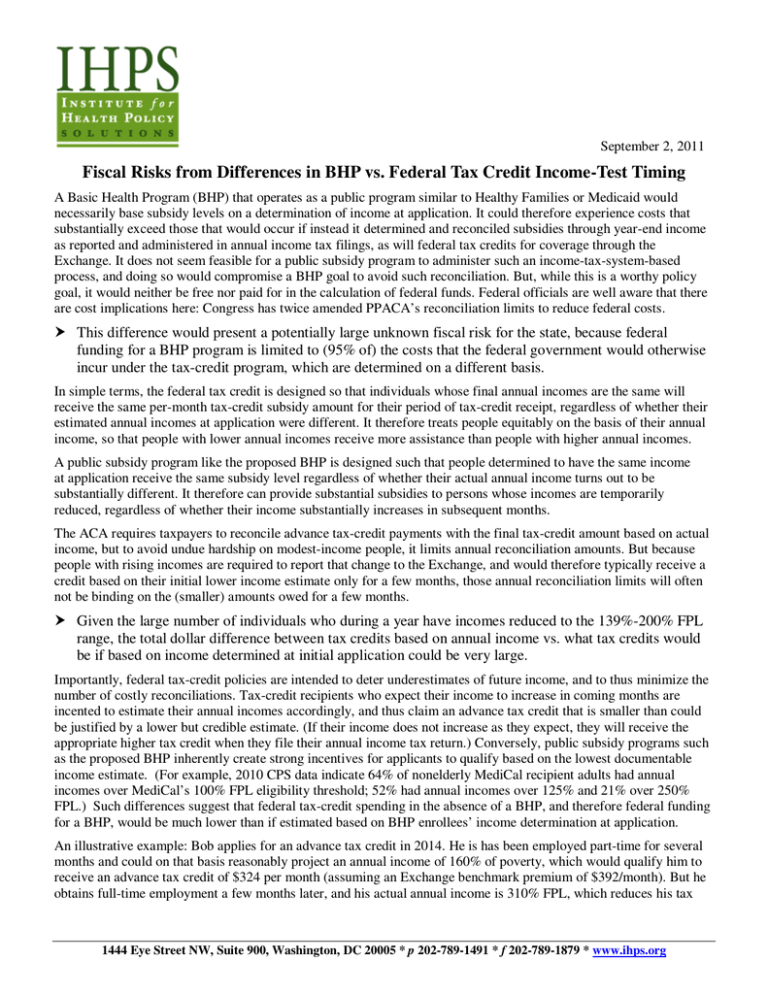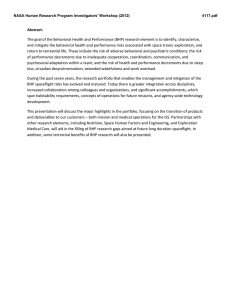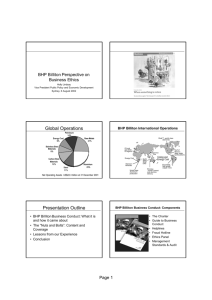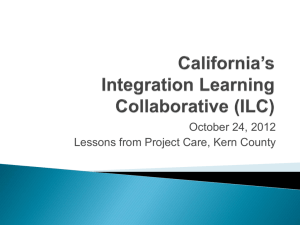Fiscal Risks from Differences in BHP vs. Federal Tax Credit Income
advertisement

September 2, 2011 Fiscal Risks from Differences in BHP vs. Federal Tax Credit Income-Test Timing A Basic Health Program (BHP) that operates as a public program similar to Healthy Families or Medicaid would necessarily base subsidy levels on a determination of income at application. It could therefore experience costs that substantially exceed those that would occur if instead it determined and reconciled subsidies through year-end income as reported and administered in annual income tax filings, as will federal tax credits for coverage through the Exchange. It does not seem feasible for a public subsidy program to administer such an income-tax-system-based process, and doing so would compromise a BHP goal to avoid such reconciliation. But, while this is a worthy policy goal, it would neither be free nor paid for in the calculation of federal funds. Federal officials are well aware that there are cost implications here: Congress has twice amended PPACA’s reconciliation limits to reduce federal costs. This difference would present a potentially large unknown fiscal risk for the state, because federal funding for a BHP program is limited to (95% of) the costs that the federal government would otherwise incur under the tax-credit program, which are determined on a different basis. In simple terms, the federal tax credit is designed so that individuals whose final annual incomes are the same will receive the same per-month tax-credit subsidy amount for their period of tax-credit receipt, regardless of whether their estimated annual incomes at application were different. It therefore treats people equitably on the basis of their annual income, so that people with lower annual incomes receive more assistance than people with higher annual incomes. A public subsidy program like the proposed BHP is designed such that people determined to have the same income at application receive the same subsidy level regardless of whether their actual annual income turns out to be substantially different. It therefore can provide substantial subsidies to persons whose incomes are temporarily reduced, regardless of whether their income substantially increases in subsequent months. The ACA requires taxpayers to reconcile advance tax-credit payments with the final tax-credit amount based on actual income, but to avoid undue hardship on modest-income people, it limits annual reconciliation amounts. But because people with rising incomes are required to report that change to the Exchange, and would therefore typically receive a credit based on their initial lower income estimate only for a few months, those annual reconciliation limits will often not be binding on the (smaller) amounts owed for a few months. Given the large number of individuals who during a year have incomes reduced to the 139%-200% FPL range, the total dollar difference between tax credits based on annual income vs. what tax credits would be if based on income determined at initial application could be very large. Importantly, federal tax-credit policies are intended to deter underestimates of future income, and to thus minimize the number of costly reconciliations. Tax-credit recipients who expect their income to increase in coming months are incented to estimate their annual incomes accordingly, and thus claim an advance tax credit that is smaller than could be justified by a lower but credible estimate. (If their income does not increase as they expect, they will receive the appropriate higher tax credit when they file their annual income tax return.) Conversely, public subsidy programs such as the proposed BHP inherently create strong incentives for applicants to qualify based on the lowest documentable income estimate. (For example, 2010 CPS data indicate 64% of nonelderly MediCal recipient adults had annual incomes over MediCal’s 100% FPL eligibility threshold; 52% had annual incomes over 125% and 21% over 250% FPL.) Such differences suggest that federal tax-credit spending in the absence of a BHP, and therefore federal funding for a BHP, would be much lower than if estimated based on BHP enrollees’ income determination at application. An illustrative example: Bob applies for an advance tax credit in 2014. He is has been employed part-time for several months and could on that basis reasonably project an annual income of 160% of poverty, which would qualify him to receive an advance tax credit of $324 per month (assuming an Exchange benchmark premium of $392/month). But he obtains full-time employment a few months later, and his actual annual income is 310% FPL, which reduces his tax 1444 Eye Street NW, Suite 900, Washington, DC 20005 * p 202-789-1491 * f 202-789-1879 * www.ihps.org credit to $111 per month. He also becomes eligible for employer coverage so that he receives the individual tax credits for only 4 months of the year. If Bob expected such full-time employment, he might well project his income accordingly under the federal tax-credit regime, e.g., to avoid having a tax obligation at the end of the year. But, if he is applying for a BHP public subsidy program, he is more likely to apply based on a projection of his current, much lower income. In this case, his actual tax credit amount would have been $111 per month, not the $324 assumed in estimates of federal funds based on income determinations by a BHP. And, if Bob received this tax credit for only four months, his $852 liability [($324-$111) x 4] would not be mitigated by the applicable annual reconciliation limit of $1,250. (Note that the particulars of Bob’s situation are simply meant to illustrate clearly various circumstances that can affect final tax-credit amounts. They are not meant to represent a typical case, which would involve smaller differences.) More generally, Federal limits on year-end tax-credit reconciliation amounts may not delimit income reconciliation reductions in federal BHP funding to the degree some expect for two reasons: First, given BHP’s exceptionally small income range and the income change data presented in the companion report,1 it is likely that many BHP recipients would enroll for periods of well under one year. In such cases, federal tax-credit reconciliation limits would have much less effect on the calculation of federal funding for BHP. Average BHP enrollment and spending could be consistent with current estimates, but it would reflect a greater number of individuals enrolled for shorter periods of time, and reduced federal funds per member per month. Second, federal estimates of what tax-credit expenses would be in the absence of a BHP could take into account that a number of BHP applicants’ income projections may more often and more significantly underestimate final incomes than would be the case in applying for tax credits. This could be estimated by making comparisons to the experience in non-BHP states. (This would also reduce the estimate of cost-sharing fill-in costs associated with such people. In Bob’s case, this would reduce estimated federal costs by an estimated additional $80 per month.) Such federal fund reductions could be somewhat offset by tax-credit cost increases for individuals whose incomes are reduced to below BHP levels and for whom reconciliation credits would be made to reduce their costs to 2% of their final annual income. But this may not generate substantial offsets. Tax-credit recipients whose current incomes fall to Medicaid levels are entitled to apply for and enroll in that program, which has no premium-contribution requirement. Federal estimates could reflect the likely experience in non-BHP states that few Exchange enrollees who become poor would continue to pay the contribution amount required to continue Exchange coverage, even though they could receive a year-end reconciliation credit. Rather, they would more likely apply for further assistance based upon their reduced current income. If so, they would be found eligible for Medicaid and enrolled in Medicaid and would not receive reconciliation credits for their Medicaid enrollment period. Since an estimated 70% of federal tax subsidies would be for persons in the BHP range, federal agencies will likely be vigilant in assuring that federal BHP costs are indeed less than what federal tax-credit costs would otherwise have been. Federal law, specifically PPACA §1331(d)(3), requires the Secretary of DHHS to assure that her estimate of federal tax-credit and cost-sharing reduction expenditures in lieu of a BHP is as accurate as possible: (A) SECRETARIAL DETERMINATION.— (ii) SPECIFIC REQUIREMENTS.—The Secretary shall make the determination under clause (i) on a per enrollee basis and shall take into account all relevant factors necessary to determine the value of the premium tax credits and cost-sharing reductions that would have been provided to eligible individuals … including … whether any reconciliation of the credit or cost-sharing reductions would have occurred if the enrollee had been so enrolled. This determination shall take into consideration the experience of other States with respect to participation in an Exchange and such credits and reductions provided to residents of the other States, with a special focus on enrollees with income below 200 percent of poverty. (iii) CERTIFICATION.—The Chief Actuary of the Centers for Medicare & Medicaid Services, in consultation with the Office of Tax Analysis of the Department of the Treasury, shall certify whether the methodology used to make determinations under this subparagraph, and such determinations, meet the requirements of clause (ii). Such certifications shall be based on sufficient data from the State and from comparable States about their experience with programs created by this Act. (B) CORRECTIONS.—The Secretary shall adjust the payment for any fiscal year to reflect any error in the determinations under subparagraph (A) for any preceding fiscal year. 1 IHPS, “Uncertainty about the Size and State Fiscal Impact of a Basic Health Program in California,” September 2, 2011. INSTITUTE FOR HEALTH POLICY SOLUTIONS 2 September 2, 2011 Preparation of this paper was supported by the California HealthCare Foundation, based in Oakland, California.




